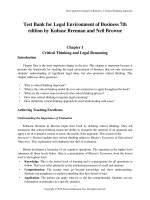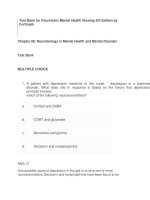Download test bank for basic concepts of psychiatric mental health nursing 8th edition by shives
Bạn đang xem bản rút gọn của tài liệu. Xem và tải ngay bản đầy đủ của tài liệu tại đây (471.52 KB, 7 trang )
Link full download:
/>
Test Bank for Basic Concepts of Psychiatric Mental
Health Nursing 8th Edition by Shives
CHAPTER 2 – HISTORY AND TRENDS
1. Which of the following is an inappropriate example of the role of a psychiatric
nurse?
A) Establishing a therapeutic relationship and environment
B) Assisting clients learn positive coping skills concerning real-life problems
C) Providing care for physical symptoms
D) Giving advice to clients on a variety of topics
Ans: D
Feedback:
All except giving advice are appropriate roles for psychiatric nurses. The role of the
psychiatric nurse is to assist the client to arrive at his or her own answers to
problems, not to give advice to the client.
2. Which of the following factors has the least influence on the development of
mental health in the client who has anxiety disorder?
A) The client’s mother also suffered from an anxiety disorder.
B) The client was raised in a household with high stress and frequent geographic
moves.
C) The client’s mother often related to her in ways that reflected her mother’s high
level of anxiety.
D) The client is often late to school and makes poor grades in most of her subjects.
Ans: D
Feedback:
Being late to school and making poor grades are behaviors that indicate that the
client is having difficulty; they are not factors influencing the development of her
anxiety disorder.
3. Which of the following describes an application of Psychiatric–Mental Health
Nursing: Scope and Standards of Practice (ANA, 2007)?
A) Diagnosing disorders using the Diagnostic and Statistical Manual III-R published
by the American Psychiatric Association
B) Assisting clients in regaining or improving previous coping abilities and
preventing further disability
C) Providing psychoanalysis to unravel psychoneuroses common to clients with
schizophrenia
D) Applying somatic therapies, such as electroconvulsive therapy, to severely
depressed clients
Ans: B
Feedback:
All of these activities except the activity described in option B are not considered to
be within the scope of practice of the psychiatric–mental health nurse.
4. An appropriate goal for clients who are learning about the healthy use of ego
defense mechanisms is what?
A) Reduce fear and protect self-esteem.
B) Eliminate anxiety and apprehension.
C) Avoid conflict and unpleasant consequences.
D) Reduce workload and communicate better.
Ans: A
Feedback:
Ego defense mechanisms help to reduce fear and protect self-esteem. It is not a goal
to eliminate anxiety, avoid conflict, or reduce workload.
5. A client asks the nurse to help her understand what her psychologist meant when
he said that she displaced her anger. The nurse replies that displacement is?
A) Replacing consciously unacceptable emotions, drives, attitudes, or needs by those
that are more acceptable
B) Making up for a real or imagined inability or deficiency by engaging in a specific
behavior to maintain self-respect or self-esteem
C) Transferring feelings, such as frustration, hostility, or anxiety, from an idea,
person, or object to one that is less threatening
D) Negating a previous unconsciously tolerable action or experience to reduce or
alleviate feelings of guilt
Ans: C
Feedback:
Displacement means the transferal of feelings from one object to another. It involves
neither replacement or making up for feelings nor negating them.
6. When comparing the theories of mental illness popular in ancient Greece with
those popular in the Middle Ages, which of the following beliefs is more applicable
to the Middle Ages?
A) Emotional disorders were believed to be an organic dysfunction.
B) Treatment included sedation, good nutrition and hygiene, and music and
recreation.
C) Mental illness was considered a disturbance of the four body fluids, or “humors.”
D) Belief in demonic possession and exorcism was common.
Ans: D
Feedback:
While some of these answers are true of both ancient Greece and the Middle Ages,
belief in demonic possession and exorcism was more common in the Middle Ages.
7. Suppression has been likened to voluntary forgetting and is used to protect one’s
self-esteem. Which of the following statements alerts the nurse to the use of this
mechanism by a 19-year-old woman who lost her leg in a car accident?
A) “I don’t remember anything about what happened to me.”
B) “I’d rather not talk about it right now.”
C) “It’s all Andy’s fault! He was going 90 miles an hour on the freeway.”
D) “My mother is heartbroken about this.”
Ans: A
Feedback:
The correct answer reflects the idea that the client has not remembered the event.
The other options imply that the client is able to remember. Suppression protects
one’s self-esteem by providing a loss of memory about the event.
8. The major goal of the Community Mental Health Act of 1963 was what?
A) Develop centers in which biopsychiatric research could take place within the
community.
B) Build mental health centers that would provide mental health care within the
local community.
C) Attract more health care providers into local psychiatric clinics.
D) Facilitate the integration of biology with the psychosocial components of
treatment.
Ans: B
Feedback:
The 1963 Community Mental Health Act was designed to provide communitycentered mental health care.
9. According to Maslow, mentally healthy people who achieve self-actualization have
the ability to do what?
A) Use varied approaches to solve problems
B) Form distant relationships with others
C) Be dependent in thought and action
D) Make decisions pertaining to fantasy rather than reality
Ans: A
Feedback:
According to Maslow, mentally healthy people who achieve self-actualization are
able to form close relationships with others, make decisions pertaining to reality
rather than fantasy, be independent or autonomous in thought and action, and use a
variety of approaches as they perform tasks and solve problems.
10. A student nurse states that he does not want to think about the upcoming final
exam. He will start studying for the exam tomorrow. The student nurse is exhibiting
which type of defense mechanism?
A) Denial
B) Suppression
C) Regression
D) Conversion
Ans: B
Feedback:
Suppression is the voluntary rejection of unacceptable thoughts or feelings from
conscious awareness. Denial is unconscious refusal to face thoughts, feelings,
wishes, needs, or reality factors that are intolerable. Regression is the retreat to past
developmental states to meet basic needs. Conversion is the unconscious expression
of a mental conflict as a physical symptom to relieve tension or anxiety.
11. Which of the following criteria is the most important component of a definition
of mental health?
A) The individual is financially self-sufficient.
B) The individual is able to cope with daily stressors.
C) The individual has rich social life.
D) The individual carries himself or herself with a joyful demeanor.
Ans: B
Feedback:
Mental health is a positive state in which one is responsible, displays self-awareness,
is self-directive, is reasonably worry free, and can cope with usual daily tensions.
Financial success, social connectedness, and a joyful demeanor may be outcomes of
mental health, but none is a prerequisite for mental health.
12. Dawn, a nursing student, is discussing the patient whom she cared for that
morning with a fellow student in the same clinical group. Dawn states that her
patient has schizophrenia and mentions that she found out that it “runs in the
patient’s family.” Dawn’s classmate is incredulous, saying that mental illness results
from traumatic circumstances. What explanation of the factors that contribute to
mental illness is most accurate?
A) Mental health is thought to be determined by genes, circumstances, and
childhood nurturing.
B) Mental health and mental illness have been proven to be genetically
predetermined.
C) Mental health is primarily a result of the effective use of ego defense mechanisms.
D) Mental health is determined by the interplay of intelligence, ingenuity, and
genetic makeup.
Ans: A
Feedback:
Three factors influence the development of mental health: genetic characteristics,
nurturing during childhood, and life circumstances.
13. Mrs. Ames is a 68-year-old widow who shares her house with her son Aaron, a
39-year-old man who has a diagnosis of bipolar disorder. Aaron has been
experiencing increasingly serious exacerbations of his illness, and the
unpredictability of his condition, combined with the fact that she is his sole
caregiver, has left her feeling exhausted and defeated. The nurse would recognize
that Mrs. Ames is at risk for what?
A) Bipolar disorder
B) Compassion fatigue
C) Failure to thrive
D) Decompensation
Ans: B
Feedback:
Compassion fatigue, also referred to by many as burnout, may occur when one
provides care for others but loses the ability to take care of oneself.
14. Which of the following statements is suggestive of the stigmatization of mental
illness?
A) “We’re sure not putting enough money into public programs for people who are
mentally ill.”
B) “It’s too bad that there aren’t better medications to treat mental illness.”
C) “I feel bad for the mentally ill, but I wish we didn’t have to see them panhandling
on every single corner.”
D) “I think that we should look at people who are mentally ill much like we see
people who are physically ill.”
Ans: C
Feedback:
Creating a division between “us” and “them” is a component of stigmatization. Being
dissatisfied with treatment options for mental illness does not mean that the
speaker is stigmatizing mental illness.
15. How can the mental health nurse best advocate for individuals with mental
illness and prevent stigmatization?
A) By emphasizing the creativity and freedom that accompany a mental illness
B) By emphasizing that all people with mental illness can eventually be cured
C) By tactfully correcting misperceptions about abnormal behavior and mental
illness
D) By informing people that most mental illness is actually a manifestation of
substance abuse
Ans: C
Feedback:
There are several perceptions about mental illness and abnormal behavior that have
the power to contribute to stigmatization. The nurse should counter these
perceptions. It would be inaccurate to characterize mental illness as a positive
experience, to state that all people with mental illness can be cured, or to attribute
mental illness to substance abuse.
16. The nurse has heard a member of public lamenting the fact that a mentally ill
person committed a high-profile crime, saying, “I don’t know what no one could see
it coming.” What perception about abnormal behavior and mental illness is this
person exhibiting?
A) Internal forces are responsible for abnormal behavior.
B) Abnormal behavior can be predicted and evaluated.
C) Maladaptive behavior is always inherited.
D) Mental illness is incurable.
Ans: B
Feedback:
If an individual believes that abnormal behavior can always be identified by warning
signs ahead of time, he or she agrees that it can be predicted.
17. In the 1970s, state mental hospitals came under increasing scrutiny and many
were closed. What was the end result of this trend?
A) Increased numbers of homeless mentally ill people
B) Higher employment rates among previously institutionalized people
C) Increased numbers of for-profit institutions for the mentally ill
D) Increased numbers of training programs for the mentally ill
Ans: A
Feedback:
In 1970, the deinstitutionalization of clients from state mental hospitals to
community living was considered a positive move; however, insufficient federal
funding resulted in an increase in the number of homeless mentally ill people.
18. Andrew has been unsuccessful in his psychiatric clinical placement and will be
obliged to repeat it next semester. The criteria for passing or failing were based on
the Psychiatric–Mental Health Nursing Scope and Standards of Practice, which are?
A) Future goals for the nursing profession as a whole
B) The legal documents that allow a nurse to practice
C) Descriptions of the responsibilities for which nurses are accountable
D) Explanations of the ideal character of the psychiatric or mental health nurse
Ans: C
Feedback:
Standards of practice are authoritative statements used by the nursing profession to
describe the responsibilities for which nurses are accountable. They do not have the
same standing as laws, and they are not future goals but are instead current
standards.
19. A recent nursing graduate has been hired as a parish nurse in the church that
she has attended for many years. How should the nurse understand this new role?
A) The nurse will focus on the assessment and management of acute illnesses
among the members of the church.
B) The nurse will implement spiritually based interventions in disease management
as an alternative to western biomedicine.
C) The nurse will consider the whole church congregation to be her client using a
community health model.
D) The nurse will serve as a specialized health advisor to the leadership of the
church.
Ans: C
Feedback:
Parish nursing is a program that promotes health and wellness of body, mind, and
spirit using the community health nursing model as its framework. The church
congregation is the client.
20. A college’s nursing program has added an elective in forensic nursing to the
curriculum. Which of the following phenomena underlies the expanded role for
forensic nursing that is expected in the future?
A) The fact that most crimes are committed by people who have mental illness
B) The fact that people with mental illness are the most common victims of crime
C) The fact that there are high rates of mental illness among the populations of jails
and prisons
D) The fact that many states now require all prison inmates to be assessed by a
mental nurse daily
Ans: C
Feedback:
Forensic nursing is expected to become one of the fastest growing nursing
specialties of the 21st century because recent studies have noted the high rates of
mental illness in jails and prisons. People with mental illness are not responsible for
most crimes. They are vulnerable to crime, but this fact does not underlie the
growth of forensic nursing.









